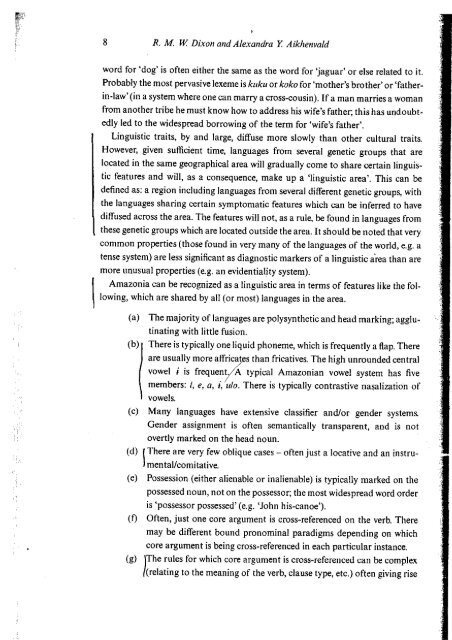The Amazonian Languages
by R.M.W. Dixon and Alexandra Y. Aikhenvald
by R.M.W. Dixon and Alexandra Y. Aikhenvald
Create successful ePaper yourself
Turn your PDF publications into a flip-book with our unique Google optimized e-Paper software.
8 R. M. W Dixon and Alexandra Y Aiklzenvald<br />
1 In/roduction<br />
9<br />
) (relating to the meaning of the verb, c1ause type, etc.) often giving rise system, i, a and 11, with no contrastive nasalization. (c-e) <strong>The</strong>re are no c1assifier or<br />
word for 'dog' is often either the same as the word for 'jaguar' or else related to it.<br />
Probably the most pervasive lexeme is kllkll or koko for 'mother's brother' or 'fatherin-Iaw'<br />
to a 'split-ergative' system. Fully accusative systems of marking for<br />
\ predicate arguments are rarely encountered.<br />
(in a system where one can marry a cross-cousin). If aman marries a woman<br />
from another tribe he must know how to address his wife's father; this has undoubtedly<br />
(h) <strong>The</strong> bound pronominal forms marking a possessor within an NP are<br />
typically the same as one of the bound pronominal paradigms for<br />
led to the widespread borrowing of the term for 'wife's father'.<br />
marking core arguments of a c1ause (sometimes the same as the A or<br />
Linguistic traits, by and large, diffuse more slowly than other cultural traits.<br />
1A/S. series, other times the same as the O or O/So series).<br />
However, given sufficient time, languages from several genetic groups that are<br />
located in the same geographical area will gradually come to share certain linguistic<br />
(i) Most (although not all) languages have prefixes; there are typically<br />
fewer prefix than suffix positions.<br />
features and will, as a consequence, make up a 'linguistic area'. This can be<br />
defined as: a region including languages from several different genetic groups, with<br />
the languages sharing certain symptomatic features which can be inferred to have<br />
diffused across the area. <strong>The</strong> features will not, as a mle, be found in languages from<br />
these genetic groups which are located outside the area. It should be noted that very<br />
common properties (those found in very many of the languages of the world, e.g. a<br />
(j) If there are several prefix positions, the bound pronominal prefix(es)<br />
will typically appear further from the root than prefixes that mark<br />
valency-changing derivations (e.g. causative, applicative). (Tucano languages<br />
are entirely suffixing; the bound pronominal suffixes appear<br />
further from the root than suffixes that mark valency-changing derivations.)<br />
tense system) are less significant as diagnostic markers of a linguistic afea than are<br />
more unusual properties (e.g. an evidentiality system).<br />
(k) Most verbal categories (e.g. tense, aspect, modality, direction) are<br />
expressed through optional suffixes.<br />
Amazonia can be recognized as a Iinguistic area in terms of features like the following,<br />
which are shared by all (or most) languages in the area.<br />
of subordination being marked on the verbo<br />
(1) Subordinate c1auses typically involve nominalized verbs, with the type<br />
(m) If there is noun incorporation, typically only those nouns which are<br />
(a) <strong>The</strong> majority of languages are polysynthetic and head marking; agglutinating<br />
with little fusiono<br />
obligatorily possessed can be incorporated, and they typically precede<br />
the verJ:¡. root.<br />
(b») <strong>The</strong>re is typically one liquid phoneme, which is frequentIy a flap. <strong>The</strong>re<br />
(n) In many languages adverbs and adpositions may be incorporated into<br />
are usually more affric~s than fricatives. <strong>The</strong> high unrounded central<br />
the verb, typically following the verb root.<br />
vowel i is frequenyA _typical <strong>Amazonian</strong> vowel system has five<br />
(o) <strong>The</strong>re is generally only a small class of lexical numbers.<br />
members: i, e, a, i, u/o. <strong>The</strong>re is typically contrastive nasalizatio"n of<br />
\ vowels.<br />
<strong>The</strong>re are of course a few exceptions to these pan-<strong>Amazonian</strong> tendencies. For<br />
(c) Many languages have extensive classifier and/or gender systems.<br />
Gender assignment is often semantically transparent, and is not<br />
overtly marked on the head noun.<br />
instance, Tupí-Guaraní languages are the only languages in Amazonia which allow<br />
incorporation of unpossessed nOllns; however, in modero languages this techniqlle<br />
is falling out of use (Seki forthcoming, Kakumasu 1986). In Nadeb, a Makú language<br />
(d) (<strong>The</strong>re are very few oblique cases - often just a locative and an instru<br />
) mental/comitative.<br />
from the Middle Rio Negro, incorporated adverbs and adpositions precede<br />
the verb root instead of following it. In Palikur, a North Arawak language from<br />
(e) Possession (either alienable or inalienable) is typically marked on the<br />
possessed noun, not on the possessor; the most widespread word order<br />
is 'possessor possessed' (e.g. '10hn his-canoe').<br />
Brazil and French Guiana, incorporated body parts follow the root (Aikhenvald<br />
and Green 1998).<br />
It is interesting to compare typological characteristics of the <strong>Amazonian</strong> linguistic<br />
(1) Often, just one core argument is cross-referenced on the verbo <strong>The</strong>re<br />
may be different bound pronominal paradigms depending on which<br />
core argument is being cross-referenced in each particular instance.<br />
area, in lowlands South America, with those of the Andean Iinguistic area<br />
in the adjacent mountains, which comprises the Quechua and Aymara families. <strong>The</strong><br />
Andean area is c1early different in almost all of the characteristics just listed. (b)<br />
(g) <strong>The</strong> rules foi" which core argument is cross-referenced can be complex<br />
<strong>The</strong>re are two or three Iiquids; fricatives rather than affricates; and a three vowel


















